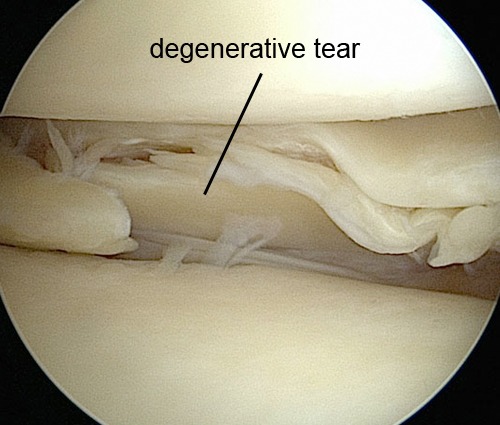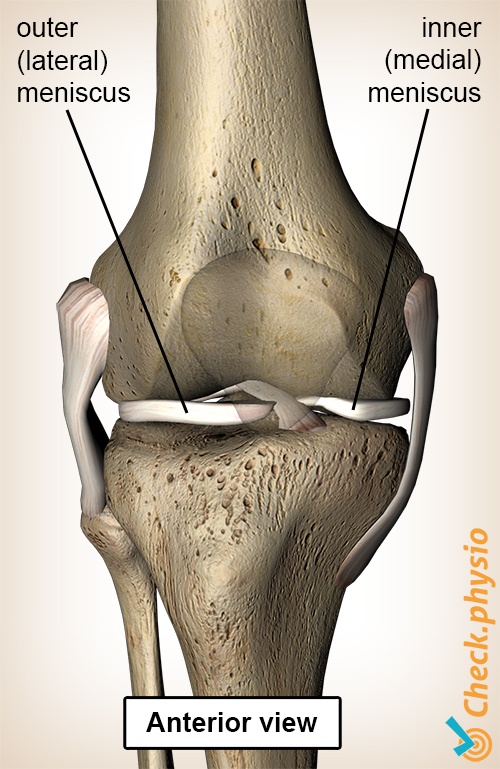- Conditions
- Degenerative meniscus injury
Degenerative meniscus injury Degenerative medial and lateral meniscus injury
Introduction
The two semi-circular disks located in the knee are called the medial and lateral meniscus. When the menisci (plural) degenerate due to ageing, we refer to this as degenerative meniscus injury.
Degeneration of the meniscus starts from the age of thirty years. The adjacent image shows a healthy and a degenerative meniscus viewed during arthroscopy.

Description of the condition
The main function of the menisci is to distribute the pressure in the knee joint. The rounded base of the thigh bone does not fit properly on the flat top of the lower leg bone. The medial and lateral menisci ensure that both bone parts fit properly without resulting in point pressure.
Both menisci also act as shock absorbers and have a proprioceptive role. Proprioception in this case means that the meniscus - as is the case with many other structures in the knee - is able to provide the body with information about the position of the knee. For example, we can feel whether the knee is flexed or extended.
In the case of a degenerative meniscus injury, there is wear-and-tear of the meniscus. The quality of the meniscus deteriorates with age and possibly with prolonged excessive strain. The meniscus becomes fragile, can tear and causes pain when weight is placed on it. If a torn piece of meniscus lodges in the hinge part of the knee, this can block movements of the knee.
Cause and origin
The symptoms develop gradually and are not preceded by any specific trauma. The symptoms become worse as wear-and-tear in the meniscus increases. As the quality and solidity of the meniscus continues to deteriorate, it also becomes susceptible to acute rupture.
Signs & symptoms
The pain is usually located on the side of the damaged meniscus. The person will experience pain when walking up and down stairs, crouching and making rotational movements with bearing weight on the knee. Walking on uneven surfaces can also lead to symptoms. In some cases, the knee is suddenly unable to flex or extend completely. These 'locking symptoms' occur because a part of the meniscus is trapped in the joint.
Diagnosis
The physiotherapist will perform a number of tests to confirm a meniscus injury. An MRI scan can be considered to obtain an impression of a degenerative meniscus.
Treatment and recovery
Degeneration of a meniscus cannot be reversed. It is possible to keep the meniscus as healthy as possible by getting regular doses of gentle exercise. Think of walking or cycling.
The physiotherapist can help you by designing an exercise programme containing stabilising, muscle strengthening and proprioception stimulating exercises. Pain, swelling, locking symptoms and a large tear all form indications for surgical treatment. There are many options for treatment that can be discussed with the orthopaedic surgeon.
Exercises
Look here for the exercise programme with exercises for a degenerative meniscus tear.
More info
You can check your symptoms using the online physiotherapy check or make an appointment with a physiotherapy practice in your area.
References
Verhaar, J.A.N. & Linden, A.J. van der (2005) Orthopedie Houten: Bohn Stafleu van Loghum.
Nugteren, K. van & Winkel, D. (2008) Onderzoek en behandeling van de knie Houten: Bohn Stafleu van Loghum.



